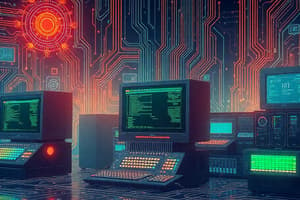Podcast
Questions and Answers
Which technology characterized the first generation of computers?
Which technology characterized the first generation of computers?
- Assembly language
- Vacuum tube circuitry (correct)
- Transistors
- Magnetic disks
What was the main type of programming language used in the first generation of computers?
What was the main type of programming language used in the first generation of computers?
- Assembly language
- Java
- Machine language (correct)
- High-level programming languages
In which generation did computers start using transistors instead of vacuum tubes?
In which generation did computers start using transistors instead of vacuum tubes?
- Fifth Generation
- Second Generation (correct)
- Third Generation
- Fourth Generation
What type of memory storage was introduced during the second generation of computers?
What type of memory storage was introduced during the second generation of computers?
Which languages were developed during the second generation of computers?
Which languages were developed during the second generation of computers?
What marked a significant leap in computer technology between the fourth and fifth generations?
What marked a significant leap in computer technology between the fourth and fifth generations?
What was a significant improvement in second-generation computers compared to first-generation computers?
What was a significant improvement in second-generation computers compared to first-generation computers?
Which technology marked the transition from second-generation to third-generation computers?
Which technology marked the transition from second-generation to third-generation computers?
What key feature differentiated third-generation computers from second-generation?
What key feature differentiated third-generation computers from second-generation?
Which technology revolutionized fourth-generation computers?
Which technology revolutionized fourth-generation computers?
What is a key characteristic of fifth-generation computers?
What is a key characteristic of fifth-generation computers?
What innovation allowed fourth-generation computers to directly reach individual users?
What innovation allowed fourth-generation computers to directly reach individual users?
Flashcards are hidden until you start studying
Study Notes
Computer Generations
Computer generations refer to the evolution of computer technology over several decades. Each generation represents a significant leap forward in terms of technology, functionality, and usage patterns. Here's an overview of the five generations of computers:
First Generation (1940s-1950s)
The first generation of computers was characterized by vacuum tube circuitry and magnetic drums for main memory. These computers were typically large, expensive, and required a lot of electricity. They relied on machine language, the lowest level of programming understanding by computers, to perform tasks. Input was based on punched cards and paper tape, while output was displayed on printouts. The UNIVAC and ENIAC computers are examples of first-generation technology. Maximum internal storage capacity was limited to around 20,000 characters, and these computers had difficulty solving complex problems beyond simple calculations.
Second Generation (1950s-1960s)
The second generation of computers saw the replacement of vacuum tubes with transistors, which allowed for smaller and more efficient machines. This period also introduced magnetic core memory, magnetic tape, and magnetic disks. Transistors led to faster and cheaper computers that generated less heat than their predecessors. The introduction of assembly language allowed programmers to specify instructions in words, while high-level programming languages like COBOL and FORTRAN were developed during this time. Second-generation computers, such as the IBM 1401 and IBM 7094, used punched cards for input and printouts for output. They stored instructions in improved forms of memory (from magnetic drum to magnetic core) and could solve multiple problems simultaneously, although still requiring manual setup.
Third Generation (1960s-1970s)
The third generation of computers was marked by the development of integrated circuits, which placed thousands of components on a single silicon chip. Integrated circuits drastically increased speed and efficiency compared to second-generation technology. Computers from this era featured a central processing unit (CPU), memory, and input/output controls all built into an integrated circuit, making them significantly smaller and more powerful. Users interacted with third-generation computers through keyboards, monitors, and interfaces connected to operating systems, allowing for multitasking capabilities. These machines became accessible to the general public due to their reduced size and cost. Examples include the IBM System/360, DEC PDP-11, and UNIVAC 1108.
Fourth Generation (1970s-Present)
Fourth-generation computers were based on microprocessors, where thousands of integrated circuits were combined onto a single silicon chip. Microprocessors brought computing power directly to individual users, leading to the rise of personal computers. In addition, graphical user interfaces (GUIs) with pointing devices and handheld technology emerged. Networking among these small computers eventually led to the development of the Internet. Input/output devices expanded beyond keyboards and printers, incorporating other types of peripherals. Real-time operating systems allowed multiple applications to run concurrently, transforming computers into versatile tools. Notable examples are the IBM PC, Apple Macintosh, STAR 1000, APPLE II, Alter 8800, and so forth.
Fifth Generation (1980s-Present)
The fifth generation of computers focuses on artificial intelligence (AI), using Ultra Large-Scale Integration (ULSI) technology and parallel processing methods. ULSI involves millions of transistors on a single microchip, enabling computers to mimic human behavior in tasks such as voice recognition, medical procedures, game playing, and even surpassing human performance in some areas. Parallel processing allows two or more microprocessors to work together on different aspects of a task simultaneously. Natural language understanding is another key characteristic of fifth-generation computers. They consume less power and generate less heat than fourth-generation machines while offering remarkable improvements in speed, accuracy, and reliability. Devices like desktops, laptops, tablets, smartphones represent this generation's technology.
Studying That Suits You
Use AI to generate personalized quizzes and flashcards to suit your learning preferences.




